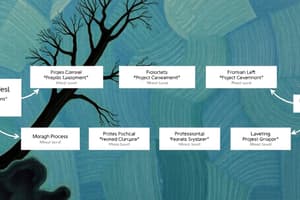Podcast
Questions and Answers
What is the main benefit of the RAD model that allows it to reduce testing time?
What is the main benefit of the RAD model that allows it to reduce testing time?
- Focusing on the reuse of templates, tools, processes, and code
- Testing prototypes individually during every iteration (correct)
- Dividing larger projects into smaller ones
- Transforming data objects into information flow
What is the primary goal of the Business Modeling phase in the RAD model?
What is the primary goal of the Business Modeling phase in the RAD model?
- To transform data objects into information flow
- To generate applications using automated tools
- To design the product based on information flow (correct)
- To refine data objects for business significance
What happens to the data objects in the Process Modeling phase?
What happens to the data objects in the Process Modeling phase?
- They are used to generate applications
- They are refined for business significance
- They are discarded
- They are transformed into information flow (correct)
What is the focus of the RAD model?
What is the focus of the RAD model?
What is the purpose of the Data Modeling phase in the RAD model?
What is the purpose of the Data Modeling phase in the RAD model?
What is the role of automated tools in the RAD model?
What is the role of automated tools in the RAD model?
What is the first phase of the requirement lifecycle?
What is the first phase of the requirement lifecycle?
What is the purpose of the Impact Assessment procedure?
What is the purpose of the Impact Assessment procedure?
What is the importance of requirement validation?
What is the importance of requirement validation?
What is included in the requirement validation phase?
What is included in the requirement validation phase?
What is the purpose of requirement documentation?
What is the purpose of requirement documentation?
Who is the intended audience of a requirements document?
Who is the intended audience of a requirements document?
What happens to the requirements after they are gathered?
What happens to the requirements after they are gathered?
What methodology can influence the requirement lifecycle?
What methodology can influence the requirement lifecycle?
When is the incremental model more suitable?
When is the incremental model more suitable?
What is a major advantage of the incremental model?
What is a major advantage of the incremental model?
What is a disadvantage of the incremental model?
What is a disadvantage of the incremental model?
What is the spiral model a combination of?
What is the spiral model a combination of?
What is the main purpose of the spiral model?
What is the main purpose of the spiral model?
Who first mentioned the spiral model?
Who first mentioned the spiral model?
What is a characteristic of the spiral model?
What is a characteristic of the spiral model?
What is the final stage of the spiral model?
What is the final stage of the spiral model?
What is the primary objective of the requirement gathering stage in SDLC?
What is the primary objective of the requirement gathering stage in SDLC?
What is the main focus of the requirement management process?
What is the main focus of the requirement management process?
What is the primary purpose of the design stage in SDLC?
What is the primary purpose of the design stage in SDLC?
What is the primary objective of the test stage in SDLC?
What is the primary objective of the test stage in SDLC?
What is STLC?
What is STLC?
What is the main purpose of a requirement document?
What is the main purpose of a requirement document?
What is the primary benefit of using requirement management tools?
What is the primary benefit of using requirement management tools?
What is the sequence of activities carried out by developers to design and develop high-quality software?
What is the sequence of activities carried out by developers to design and develop high-quality software?
What is the primary characteristic of the incremental model in software development?
What is the primary characteristic of the incremental model in software development?
What happens to the system after the first increment is delivered?
What happens to the system after the first increment is delivered?
What is the priority in tackling requirements in the incremental model?
What is the priority in tackling requirements in the incremental model?
How is system development organized in the incremental model?
How is system development organized in the incremental model?
What is the result of each iteration in the incremental model?
What is the result of each iteration in the incremental model?
When is the core product analyzed by the client in the incremental model?
When is the core product analyzed by the client in the incremental model?
Flashcards are hidden until you start studying
Study Notes
SDLC Methodologies
- Incremental Model is used when demand for an early release of a product arises, when the software engineering team is not very well skilled or trained, and when high-risk features and goals are involved.
- It is commonly used for web application and product-based companies.
- The advantages of the Incremental Model include:
- Quick generation of software during the software life cycle.
- Flexibility and low cost to change requirements and scope.
- Easy identification of errors.
- Less costly compared to others.
- Customer can respond to each building.
- The disadvantages of the Incremental Model include:
- Requires good planning and designing.
- Problems may arise due to system architecture.
- Each iteration phase is rigid and does not overlap each other.
- Rectifying a problem in one unit requires correction in all the units and consumes a lot of time.
Spiral Model
- The Spiral Model is a combination of the waterfall model and iterative model.
- Each phase in the Spiral Model begins with a design goal and ends with the client reviewing the progress.
- The Spiral Model was first mentioned by Barry Boehm in his 1986 paper.
- The development team in the Spiral-SDLC model starts with a small set of requirements and goes through each development phase for those set of requirements.
- The software engineering team adds functionality for the additional requirement in every-increasing spirals until the application is ready for the production phase.
Requirement Life Cycle
- Requirement Life Cycle involves several phases and can be a complicated process.
- The nature of the process depends on the methodology chosen for software development.
- Each phase may involve a lot of paperwork and approval procedures.
- It deals with project documents like a project proposal, project management plan, project scope, and the business case.
Phases of Requirement Life Cycle
- Phase 1: Requirement Definition (Requirement extraction)
- Phase 2: Requirement Validation (Analyzing the needs or conditions required to meet a new or altered product)
- Phase 3: Requirement Documentation (Formal written documents that outline the technical and logical requirements of a project)
- Phase 4: Requirement Management (Planning, monitoring, analyzing, communicating, and managing requirements)
Software Development Life Cycle (SDLC)
- SDLC is the sequence of activities carried out by developers to design and develop high-quality software.
- Different phases of SDLC include:
- Requirement Gathering
- Design Stage
- Build Stage
- Test Stage
Rapid Application Development (RAD) Model
- RAD model focuses on the reuse of templates, tools, processes, and code.
- Different phases of RAD model include:
- Business Modeling
- Data Modeling
- Process Modeling
- Application Generation
- Testing and Turnover
- RAD model is used when there is a need to develop software quickly and with a high degree of quality.
Studying That Suits You
Use AI to generate personalized quizzes and flashcards to suit your learning preferences.




